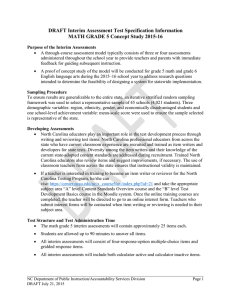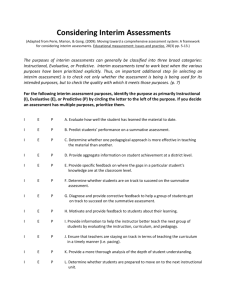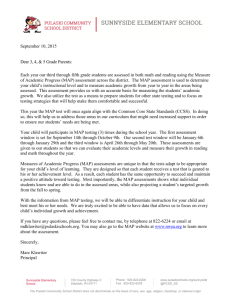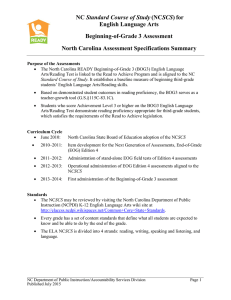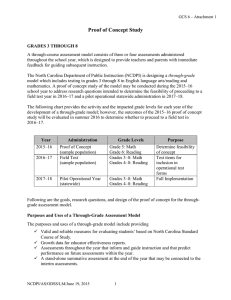DRAFT Interim Assessment Test Specification Information
advertisement
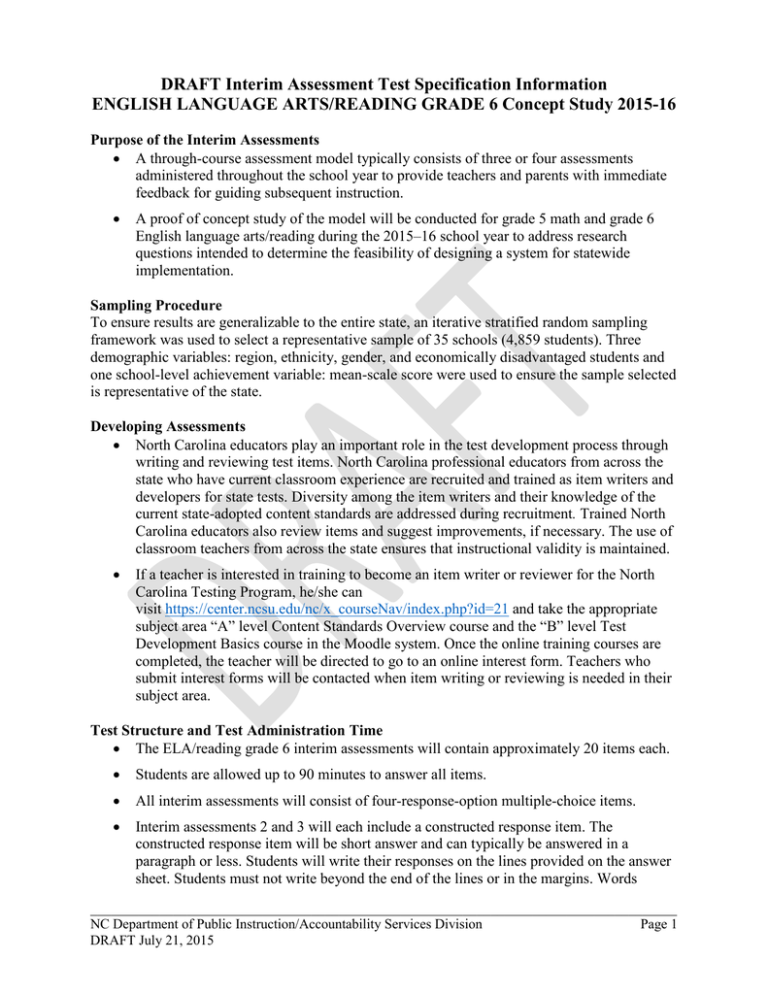
DRAFT Interim Assessment Test Specification Information ENGLISH LANGUAGE ARTS/READING GRADE 6 Concept Study 2015-16 Purpose of the Interim Assessments • A through-course assessment model typically consists of three or four assessments administered throughout the school year to provide teachers and parents with immediate feedback for guiding subsequent instruction. • A proof of concept study of the model will be conducted for grade 5 math and grade 6 English language arts/reading during the 2015–16 school year to address research questions intended to determine the feasibility of designing a system for statewide implementation. Sampling Procedure To ensure results are generalizable to the entire state, an iterative stratified random sampling framework was used to select a representative sample of 35 schools (4,859 students). Three demographic variables: region, ethnicity, gender, and economically disadvantaged students and one school-level achievement variable: mean-scale score were used to ensure the sample selected is representative of the state. Developing Assessments • North Carolina educators play an important role in the test development process through writing and reviewing test items. North Carolina professional educators from across the state who have current classroom experience are recruited and trained as item writers and developers for state tests. Diversity among the item writers and their knowledge of the current state-adopted content standards are addressed during recruitment. Trained North Carolina educators also review items and suggest improvements, if necessary. The use of classroom teachers from across the state ensures that instructional validity is maintained. • If a teacher is interested in training to become an item writer or reviewer for the North Carolina Testing Program, he/she can visit https://center.ncsu.edu/nc/x_courseNav/index.php?id=21 and take the appropriate subject area “A” level Content Standards Overview course and the “B” level Test Development Basics course in the Moodle system. Once the online training courses are completed, the teacher will be directed to go to an online interest form. Teachers who submit interest forms will be contacted when item writing or reviewing is needed in their subject area. Test Structure and Test Administration Time • The ELA/reading grade 6 interim assessments will contain approximately 20 items each. • Students are allowed up to 90 minutes to answer all items. • All interim assessments will consist of four-response-option multiple-choice items. • Interim assessments 2 and 3 will each include a constructed response item. The constructed response item will be short answer and can typically be answered in a paragraph or less. Students will write their responses on the lines provided on the answer sheet. Students must not write beyond the end of the lines or in the margins. Words _____________________________________________________________________________________ NC Department of Public Instruction/Accountability Services Division Page 1 DRAFT July 21, 2015 written in the margins or unlined areas of the answer sheet will not be scored. Students must not add more lines to the answer sheet. Words written on extra lines will not be scored. Scorers only review for the specific criteria as stated in the item. Additional information not required in the answer will not increase the student’s score. Prioritization of Standards • The NCDPI invited teachers to collaborate and develop recommendations for a prioritization of the standards indicating the relative importance of each standard, the anticipated instructional time, and the appropriateness of the standard for multiple-choice and constructed response item formats. • Interim assessments are aligned to the NC Standard Course of Study (NCSCS) for English Language Arts, adopted by the North Carolina State Board of Education in June 2010. • Some standards not designated with tested items may be a prerequisite standard or may be tested within the context of another standard. • The NCSCS may be reviewed by visiting the NCDPI K-12 English Language Arts wiki site at http://elaccss.ncdpi.wikispaces.net/Common+Core+State+Standards. • Some content standards in the NCSCS are not directly assessed because either (1) the standard cannot be appropriately assessed during a limited time assessment using multiple-choice and/or constructed response items or (2) the standard is better assessed through another, more inclusive standard. • The following standards are assessed on each ELA/reading interim assessment. o RL.1, RL.2, RL.3, RL.4, RL.5, L.4a, L.5.a o RI.1, RI.2, RI.3, RI.4, RI.5, RI.6, RI.8 • All students are expected to be able to comprehend texts of steadily increasing complexity as they progress through a grade. Both quantitative and qualitative measures are used to determine the complexity of a text. The qualitative measure of text complexity includes making informed decisions about the difficulty of a text in terms of a number of factors such as levels of meaning or purpose, structure, language conventionality and clarity, and knowledge demands. The text complexity of the selections chosen for the proof of concept study will increase throughout the year. Cognitive Rigor and Item Complexity Assessment items are designed, developed, and classified to ensure that the cognitive rigor of the test forms aligns to the cognitive complexity and demands of the NCSCS for English Language Arts. These items will require students to demonstrate the range of cognitive processes from recall of information to the application of concepts and skills. Delivery Mode All interim assessments will be delivered on paper-and-pencil. _____________________________________________________________________________________ NC Department of Public Instruction/Accountability Services Division Page 2 DRAFT July 21, 2015
